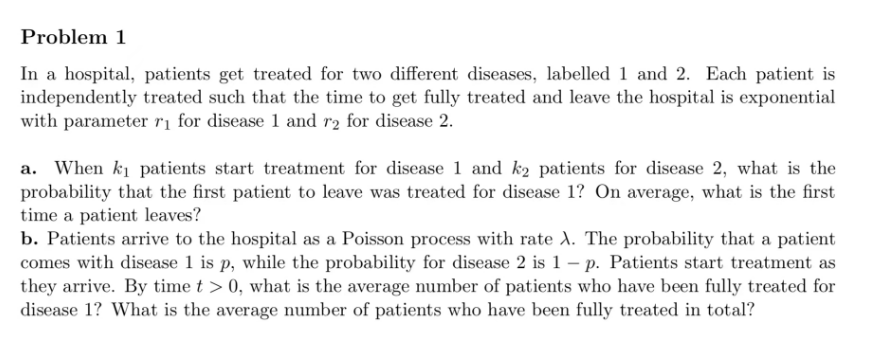for disease 2. for disease 1 and k₂ patients for disease ve was treated for disease 1? On average, w Poisson process with rate A. The probability obability for disease 2 is 1- p. Patients sta average number of patients who have been of patients who have been fully treated in
for disease 2. for disease 1 and k₂ patients for disease ve was treated for disease 1? On average, w Poisson process with rate A. The probability obability for disease 2 is 1- p. Patients sta average number of patients who have been of patients who have been fully treated in
Algebra and Trigonometry (MindTap Course List)
4th Edition
ISBN:9781305071742
Author:James Stewart, Lothar Redlin, Saleem Watson
Publisher:James Stewart, Lothar Redlin, Saleem Watson
Chapter10: Systems Of Equations And Inequalities
Section10.FOM: Focus On Modeling: Linear Programming
Problem 14P
Related questions
Question

Transcribed Image Text:Problem 1
In a hospital, patients get treated for two different diseases, labelled 1 and 2. Each patient is
independently treated such that the time to get fully treated and leave the hospital is exponential
with parameter r₁ for disease 1 and r2 for disease 2.
a. When k₁ patients start treatment for disease 1 and k2 patients for disease 2, what is the
probability that the first patient to leave was treated for disease 1? On average, what is the first
time a patient leaves?
b. Patients arrive to the hospital as a Poisson process with rate A. The probability that a patient
comes with disease 1 is p, while the probability for disease 2 is 1-p. Patients start treatment as
they arrive. By time t > 0, what is the average number of patients who have been fully treated for
disease 1? What is the average number of patients who have been fully treated in total?
Expert Solution
This question has been solved!
Explore an expertly crafted, step-by-step solution for a thorough understanding of key concepts.
Step by step
Solved in 2 steps

Recommended textbooks for you

Algebra and Trigonometry (MindTap Course List)
Algebra
ISBN:
9781305071742
Author:
James Stewart, Lothar Redlin, Saleem Watson
Publisher:
Cengage Learning

Algebra and Trigonometry (MindTap Course List)
Algebra
ISBN:
9781305071742
Author:
James Stewart, Lothar Redlin, Saleem Watson
Publisher:
Cengage Learning